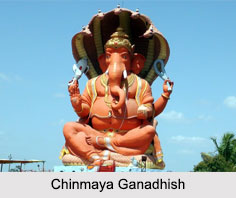 Located in the Indian state of Maharashtra in Kolhapur, close to the Pune- Bengaluru highway, the Chinmaya Ganadhish statue is a 61ft tall idol of Lord Ganesh seated on a 24ft tall meditation hall. The circular structure has a diameter of about 60 ft and weighs about 800 tonnes. There are about 24 pillars supporting the idol of Lord Ganesha and about 50 skilled workers were called from Shimoga in Karnataka to complete the statue within a year.
Located in the Indian state of Maharashtra in Kolhapur, close to the Pune- Bengaluru highway, the Chinmaya Ganadhish statue is a 61ft tall idol of Lord Ganesh seated on a 24ft tall meditation hall. The circular structure has a diameter of about 60 ft and weighs about 800 tonnes. There are about 24 pillars supporting the idol of Lord Ganesha and about 50 skilled workers were called from Shimoga in Karnataka to complete the statue within a year.
The Chinmaya Ganadhish statue was inaugurated on 19th November, 2001 by Swami Tejoymayananda. The statue was built under the guidance of Swami Purushottamananda, who is the regional head for the Maharashtra- Gujarat- Goa zone. Currently, the place is a pilgrimage spot and is visited by people especially during the festival of Sankashti Chaturthi.
This article is a stub. You can enrich by adding more information to it. Send your Write Up to content@indianetzone.com.



















